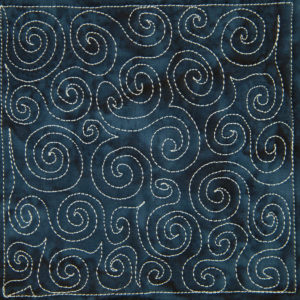Free-motion quilting has been a constant discussion online in the quilting community and industry. What does free-motion quilting necessarily mean? Free-motion quilting is just like it sounds. Free-motion quilting is a technique used where stitches are added by swiftly sewing in any direction freely just on the surface of the quilt top. When free-motion quilting you are in control – not the machine, meaning you have to move the fabric under the needle in a certain motion creating a pattern.
When doing free-motion quilting you can make any type of design pattern such as simple circles to detailed leaves or echo quilting where you outline a focal point. Another way to free-motion quilt is to simply meander and let your hands simply guide wherever and watch your design come to life. This is a great way to add more design and technique to your quilt, however be aware that it takes a lot of time and dedication to build this skill. Here are some images below that show just how unique and different free-motion quilting can be.
There are two essentials things that you need before starting
- Disengage the feed dogs in order to do free-motion quilting
- A free-motion foot specific to your machine
One important tip about free-motion quilting is that thread tension can easily occur, so if you are a beginner first practice without the sewing thread in the needle in you’re sewing machine. Once you get more comfortable then add thread and then still practice some more. It will take time and patience to get the tension just right. Use top stitch needles size 90/14 in order to give you good results. For more detailed information and pictures explaining thread tension check out Greta’s Quilting Studio.
Another important tip is about the batting and what kind to use when doing free-motion quilting. First off the thinner your batting is, the more issues you are going to have with tension while sewing. Instead choose a batting that is thicker allowing more room for your stitches to interlock creating less tension. A good batting for free-motion quilting is one that is 80% cotton and 20 % polyester, this allows a better quilting texture.
Lastly when re-positioning your hands when you get close to the needle make sure to stop with the needle down before moving your hands back so as not to hurt yourself. Also by doing this it is ensuring that the fabric doesn’t move or budge while you re-position your hands properly. Most importantly when it comes to free-motion quilting always practice, practice and practice in order to improve the quality of your stitching designs.
Make sure to share with us on Quilter’s Thread mobile app your favorite free-motion quilting designs and tricks!
Live Well. Quilt Well.


